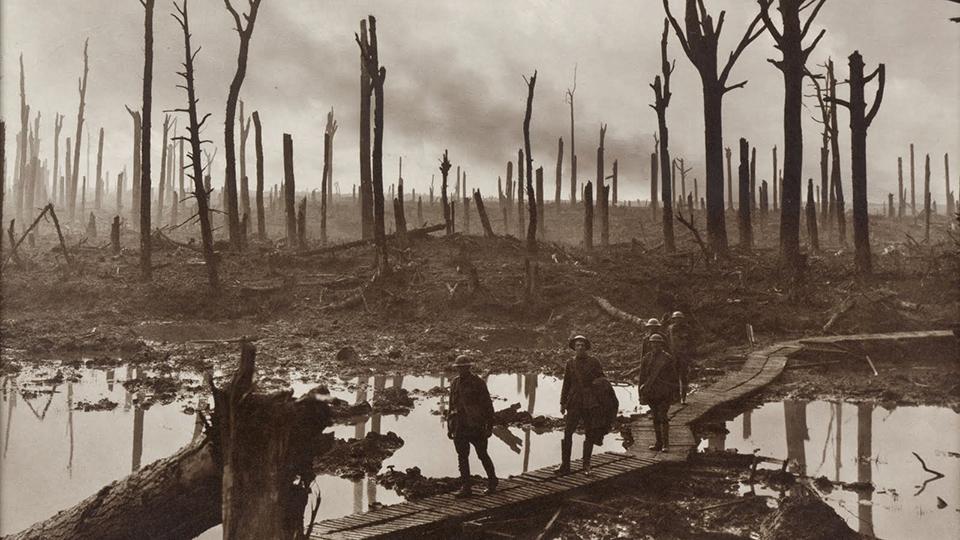Passchendaele and Ireland’s war
Primary page content
On the centenary of the Battle of Passchendaele an academic from Goldsmiths, University of London looks at its place in Irish history.

Soldiers crossing mud near Chateauwood. Why is Irish involvement in Passchendaele now forgotten? Photo: IWM
31 July 1917 saw the start of the Third Battle of Ypres, commonly known as the Battle of Passchendaele, in Belgium, in which hundreds of thousands of Allied and German soldiers would lose their lives.
Richard Grayson, Professor of Twentieth Century History at Goldsmiths, has written extensively on Ireland and the First World War and as an Associate Member of the Northern Ireland Centenary Committee is involved in the centenary commemorations.
I asked Richard about Passchendaele, the overlooked role of Irish soldiers, and his own family connection to the battle.
Pete Wilton: How did you come to study Passchendaele in such great detail?
Richard Grayson: Any historian of the First World War looking at operations on the Western Front has to engage with the battle because after the Somme, it is probably the most important British battle of the war. It certainly saw very heavy losses, but it is also academically interesting because it is central in debates about the British army's 'learning curve'.
It's also important for anyone studying Ireland's war because the 36th (Ulster) and 16th (Irish) Divisions were close together in phases of the battle yet that is relatively forgotten compared to the more widely known story of 'side by side' service at Messines about two months before.
PW: What is it about Passchendaele that makes it so important?
RG: Passchendaele is important for the public because more than any other Western Front battle it embodies the idea that so many have of men floundering in mud. Many public views of the war are wildly inaccurate, but Passchendaele was actually like that. Despite being fought over the summer, the rain was heavy for much of the battle which, combined with persistent artillery fire, meant that the area became a quagmire.
But we should also pay attention to the battle because it has an important place in debates on the 'learning curve' within the British army. Despite all that went wrong and the heavy casualties (around 260,000 on each side between 31st July and 10th November 1917), there were successes for the allies who learned to develop 'bite and hold' tactics.
PW: How have historians' views of the battle changed over recent years?
RG: Much of the debate has been around casualties, with a dramatic reduction of estimates of German casualties from around 400,000 in the inter-war years to around 260,000 now. There has also been much debate over how far the battle and its various phases can be seen as an allied success. Historians are now more likely to see the battle as witnessing the development of 'bite and hold' tactics. This involved securing small targets rather than seeking to advance on a broad front all at once, and were an element in the success of the allies in 1918.
PW: Why do you think Passchendaele has been forgotten in Northern Ireland?
RG: I think the Somme looms so much larger for loyalists because of the 36th (Ulster) Division's service on 1st July 1916 when it was one of relatively few British units to make substantial (though only temporary) gains. Meanwhile, the 16th (Irish) Division's service on the Somme in September 1916 was in one of the relatively successful phases of the battle.
Since the Somme was the central battle of the UK's war it is understandable that the place of the two divisions in it has been highlighted. Meanwhile, for a story of side by side service, the battle of Messines in early June 1917 was a huge success in contrast to the disaster of Passchendaele, and has perhaps offered a better site for reconciliation. But Passchendaele is a battle we should know about more today because it involved Ireland's two volunteer divisions on the Western Front.
PW: Can you explain your personal connection to the battle?
RG: My paternal grandparents, Edward Grayson and Maud Powell, were both from Lurgan in County Armagh, born in the 1890s. Maud had three brothers in the British army in the First World War. James was killed in September 1915 in the 2nd Royal Irish Rifles. Charles and Joseph both served in the Ulster Division and almost certainly served at Passchendaele (and more specifically the Langemarck phase of the battle). Both survived, though Charles, serving in the 9th and later 15th Royal Irish Rifles, was captured by the Germans in March 1918 and held prisoner for the rest of the war.